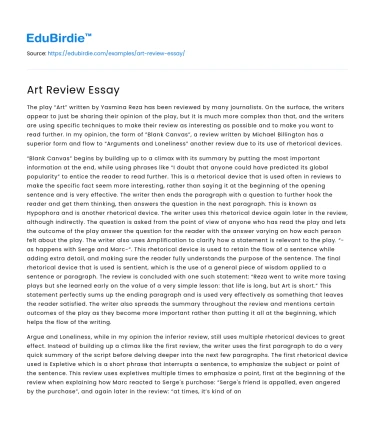The play “Art” written by Yasmina Reza has been reviewed by many journalists. On the surface, the writers appear to just be sharing their opinion of the play, but it is much more complex than that, and the writers are using specific techniques to make their review as interesting as possible and to make you want to read further. In my opinion, the form of ”Blank Canvas”, a review written by Michael Billington has a superior form and flow to “Arguments and Loneliness” another review due to its use of rhetorical devices.
“Blank Canvas” begins by building up to a climax with its summary by putting the most important information at the end, while using phrases like “I doubt that anyone could have predicted its global popularity” to entice the reader to read further. This is a rhetorical device that is used often in reviews to make the specific fact seem more interesting, rather than saying it at the beginning of the opening sentence and is very effective. The writer then ends the paragraph with a question to further hook the reader and get them thinking, then answers the question in the next paragraph. This is known as Hypophora and is another rhetorical device. The writer uses this rhetorical device again later in the review, although indirectly. The question is asked from the point of view of anyone who has read the play and lets the outcome of the play answer the question for the reader with the answer varying on how each person felt about the play. The writer also uses Amplification to clarify how a statement is relevant to the play. “-as happens with Serge and Marc-“. This rhetorical device is used to retain the flow of a sentence while adding extra detail, and making sure the reader fully understands the purpose of the sentence. The final rhetorical device that is used is sentient, which is the use of a general piece of wisdom applied to a sentence or paragraph. The review is concluded with one such statement: “Reza went to write more taxing plays but she learned early on the value of a very simple lesson: that life is long, but Art is short.” This statement perfectly sums up the ending paragraph and is used very effectively as something that leaves the reader satisfied. The writer also spreads the summary throughout the review and mentions certain outcomes of the play as they become more important rather than putting it all at the beginning, which helps the flow of the writing.
Save your time!
We can take care of your essay
- Proper editing and formatting
- Free revision, title page, and bibliography
- Flexible prices and money-back guarantee
Argue and Loneliness, while in my opinion the inferior review, still uses multiple rhetorical devices to great effect. Instead of building up a climax like the first review, the writer uses the first paragraph to do a very quick summary of the script before delving deeper into the next few paragraphs. The first rhetorical device used is Expletive which is a short phrase that interrupts a sentence, to emphasize the subject or point of the sentence. This review uses expletives multiple times to emphasize a point, first at the beginning of the review when explaining how Marc reacted to Serge's purchase: “Serge's friend is appalled, even angered by the purchase”, and again later in the review: “at times, it’s kind of an intellectual Punch and Judy show”. The phrases “even angered” and “at times” are expletive phrases. The next rhetorical device used is Antanagoge. Antanagoge is stating a negative point, then pointing out a positive immediately after to soften the blow of the negative point. It is used in this review to say that it is unrealistic how much conflict a white painting can create, but the play does bring up interesting questions by having that. Moving on, the writer uses a poetic device known as an allegorical figure, which is the application of a human characteristic given to a concept. In this case, the concept is loneliness, and this is demonstrated by the phrase “Aching loneliness is waiting in the wings”. The last rhetorical device used in this review is Scesis Onomaton, which is the use of multiple phrases or statements that mean the same thing to emphasize the statement. In the review, it is used to emphasize that the painting in the play “Art” could hardly be considered modern art: “Reza treats a white-on-white painting as if it were the latest, trendiest thing.
Blank Canvas made better use of rhetorical devices, and the climax and the Hyphoria(questions that are flowed by an answer) are very effective in luring you into reading more. Argue and loneliness used some of the less important rhetorical devices that only affected singular sentences, whereas the devices used in Blank Canvas affected entire paragraphs.






 Stuck on your essay?
Stuck on your essay?

